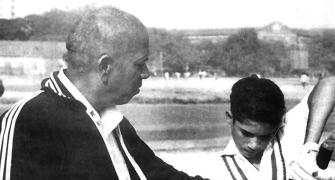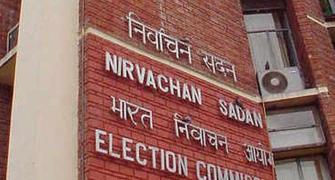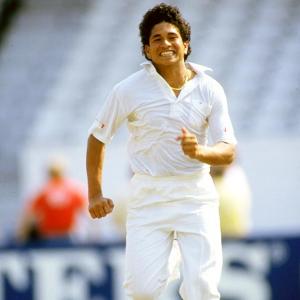Sachin Tendulkar.
An inspiration to a nation.
An icon of his sport.
Sachin's life offers many, many, lessons, as Devendra Prabhudesai explains in his new book, Winning Like Sachin. Think & Succeed Like Tendulkar, from which this fascinating glimpse we are proud to post today, the Master's 45th birthday.

The best performer of the ICC Cricket World Cup 2003, which was co-hosted by South Africa, Zimbabwe and Kenya, was Sachin, who amassed 673 runs, exactly 150 more than his 1996 tally.
He had batted in the middle order in the months leading up to the event because his team had requested him to.
Egged on by Javagal Srinath and Anil Kumble, John Wright, India's coach, sought Sachin out before the start of the tournament and asked him where he would like to bat.
Sachin's response was that he would bat wherever the team wanted him to.
When Wright persisted, Sachin reluctantly admitted that if he were given the choice, then he would like to open.
Would he have batted as outstandingly in the competition had he not been restored to the opening slot?
Yes, most certainly! For him, the team always came before self.
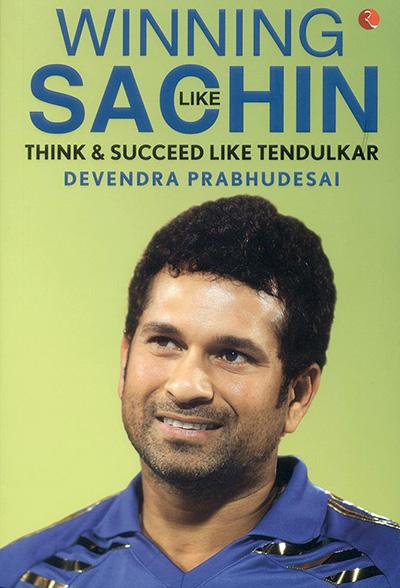
Apart from the issues with his back, Sachin also had problems with his ankle, which he had injured on the tour of New Zealand, a couple of months previously.
Strapping the ankle before every practice session and match was an ordeal, and the wound would sting when it would come in contact with sea water during the team's recovery sessions on the beach.
He had a torn ligament and tendon in a finger, which made it difficult for him to even hold a cup of tea properly.
He also had a strained hamstring, due to which he could not jog or sprint with his team-mates and had to cycle instead.
But then, he viewed all these as minor irritants.
These were not going to affect him and his resolve to go the distance.

The Indian team did not get off to the best of starts in the tournament.
A lacklustre victory over Holland was followed by a shoddy performance against Australia.
The defending champions bowled India out for 125 and won by 9 wickets.
Sourav Ganguly and his men still had four more league matches left to make a bid for qualifying to the 'Super Sixes' stage of the tournament, but their detractors were determined to make a splash after the fiasco against Australia.
What ensued was as horrendous as it was ridiculous.
Effigies of the players were burnt and houses of some stoned.
Some former players also joined the bandwagon, slamming the Indian players as if they had committed an act of terrorism.
Members of the Indian media were also not endearing themselves to the players with the questions that they were posing at media conferences.
Sachin was neither the captain nor the vice-captain, but in terms of stature, he had no equal in the squad.
Being someone who valued a leader's responsibilities more than his entitlements, there was no question of his not standing up for his team-mates when the situation demanded the same.
Members of the fourth estate were surprised when he strode into the media conference hall before his team's next game of the tournament, against Zimbabwe at Harare.
He proceeded to read out the following message:
'We ourselves are disappointed with the kind of performance we all have put up.'
'I also understand the disappointment you have gone through.'
'I am just here to assure you that we will be fighting till the last ball is bowled.'
Having made a statement, literally and figuratively, he exited the hall.
John Wright, the then coach of the Indian team, likened the statement to a 'Papal pronouncement' in his memoirs.
There was no other member of the Indian team who could have silenced the rabble-rousers and boosted the spirits of the supporters, the way Sachin did by uttering those three sentences.
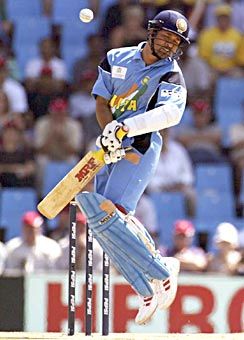
Australia won by 9 wickets after India were shot out for 125.
Having made a statement off the field, Sachin and his teammates set out to do likewise on it.
He scored a match-winning 81 against Zimbabwe and starred in India's next two games as well, with knocks of 152 against Namibia and 50 against England.
His team-mates put up a splendid show with the bat, ball and in the field, and they sealed a spot in the 'Super Sixes' with four wins from five games.
However, they were aware that a reverse in their next game could push them back to square one, not in the points table, but certainly mentally.
On the other hand, a victory in what was for all practical purposes, a final before the final, would give them a shot in the arm on the eve of the second stage of the tournament.
Streets across the subcontinent wore a deserted look on the afternoon of March 1, 2003, when Sourav Ganguly accompanied Waqar Younis, his Pakistani counterpart, for the toss at the SuperSport Park, Centurion.
Waqar won the toss and opted to bat, and Pakistan scored 273/7.
History was not on India's side.
Their previous highest successful chase in the World Cup was 222.
Sachin shut himself off from the world in the break.
He padded up, plugged on his earphones and told the 12th man to alert him when it was time to leave the dressing room.
As they made their way to the middle, Sachin reminded Virender Sehwag, his opening partner, that they needed to be cautious in the initial overs.
Sehwag agreed with his senior's assessment that the Pakistanis would go flat out for wickets in the opening overs.
Sachin usually did not take strike when he opened in ODIs, but the significance of the occasion prompted him to do something different to try and seize the initiative.
He decided to face Wasim Akram's first ball.
To those watching, it was a stirring display of leadership, even before he had faced a ball.
He struck a boundary in the very first over and then took a single.
When he crossed over to the non-striker's end, the umpire asked him why he had taken strike.
Sachin's reply said it all: 'I want to impose myself on this match.'
The leader had made a statement.
Sehwag also hit a boundary in Akram's first over.
In the second over, Sachin faced Shoaib Akhtar, the fastest bowler in the world.
After three uneventful balls, Sachin struck him for a six over third man.
He followed it with a flick for four and then a defensive push, which was timed so well that he got another boundary.
Shoaib, clearly shell-shocked by Sachin's assault, was taken off after just one over and Waqar brought himself on from his end.
Sehwag struck the Pakistani captain's first delivery over the covers for six.
The Indian openers had realised by then that the bowling was not up to the mark.
Therefore, it made sense to abandon plan A and implement plan B instead.
Their ability to alter their game plan enabled them to take the game away from their opponents in next to no time.
The horse had bolted by the time the Pakistanis came to terms with what had happened.
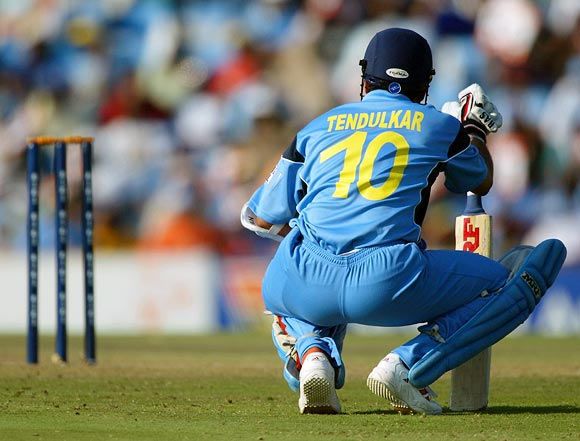
India did not lose the psychological advantage even when Waqar dismissed Sehwag and Ganguly fell in quick succession.
The pressure of playing the 'arch enemy' had brought out the best in Sachin, who kept sending the spectators, TV viewers and commentators into raptures with his strokes.
He batted fluently until his hamstring started acting up.
The obvious thing to do was to ask for a runner, but then, he had always been reluctant to ask for one, his reasoning being that his mind was his own and there was no way a runner would know what was going on in it.
Sachin's dedication to his craft boosted his anticipatory skills to incredible levels.
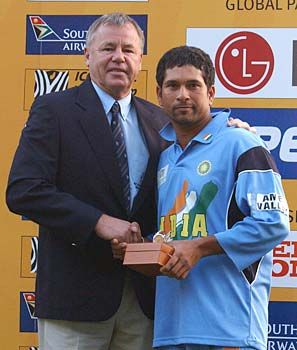
India were touring England in 2007 when the TV broadcaster acted on a hunch and maxed the volume of the stump microphones when he was on strike.
The crew was stunned to hear him utter the exact number of runs he expected to score from a delivery even before he made contact with the ball!
It appeared that Sachin knew what he would do with the ball as soon as it was released by the bowler.
He could not have reached this level of batting perfection merely on the strength of his talent.
He had worked hard to get there.
Against Pakistan at Centurion in the 2003 World Cup, Sachin eventually asked for a runner, but he fell soon after for 98.
His team-mates completed what he had started and took India to victory with plenty of overs to spare.
India played brilliantly in the subsequent games and took on Australia, the only team they had lost to in the competition, in the final at Johannesburg.
India won the toss and elected to field, but the decision backfired as the Australians batted magnificently to amass 359/2.
Sachin fell in the very first over of India's innings and it was an uphill struggle thereafter.
He made no secret of the fact that he would have traded his 673 runs in the tournament and the Player of the Tournament Award for the World Cup.
Excerpted from Winning Like Sachin. Think & Succeed Like Tendulkar, by Devendra Prabhudesai, Rupa & Co, with the publisher's kind permission.


